Related Research Articles
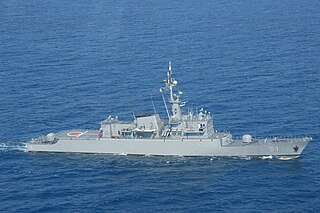
The Almirante Padilla-class frigates is a series of frigates operated by the Colombian Navy. The designation of this class is Type FS 1500 and there are four ships in service. The ships were built by Howaldtswerke-Deutsche Werft (HDW) at Kiel, West Germany in the 1980s, with the first vessel commissioning in 1983 and the last in 1984. The frigates have undergone significant modification over their careers with the 2012 Orion Program Upgrade significantly modernising the vessels. Two similar ships operate as the Kasturi-class corvettes in the Royal Malaysian Navy.

The Yıldız class is series of two fast attack craft/missile boats of the Turkish Navy. They class was designed by Lürssen Werft of Germany and share the same hull layout as the preceding Doğan class. Both ships of the class were built in Turkey and entered service in 1996. They remain in service.

The Inhaúma class are a series of five corvettes operated by the Brazilian Navy. These ships were built in Brazil and designed with assistance from the German company Marine Technik. It was originally planned to build 12 to 16 ships but the economic situation in Brazil did not permit this and only five vessels were built. The first two ships were constructed at the Arsenal de Marinha in Rio de Janeiro, the second pair by Verolme. The programme was considerably delayed due to funding issues and the Brazilian Verolme yard's insolvency in 1991 which forced Júlio de Noronha and Frontin to be completed by Arsenal da Marinha. The first ship entered service in 1989 and the last in 2008. Three of the five ships have been taken out of service and one was sunk in a missile exercise in the Atlantic Ocean in 2016.
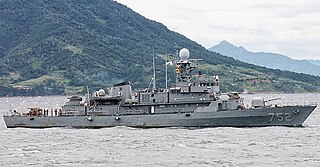
The Donghae-class corvette is a class of four ships of the Republic of Korea Navy used for coastal patrol duties. Each corvette is armed with one Oto Melara 76 mm compact gun, three AA guns, six torpedoes and twelve depth charges for anti-submarine operations. The ships resemble the later Pohang class, but have slightly different armament.
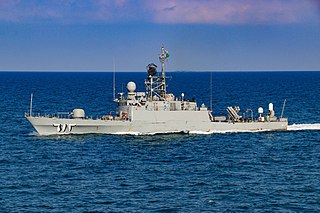
The Badr class is a class of corvette built by the United States and operated by the Saudi Navy. The class has been relegated to a coastal defence role following the modernisation of the Saudi fleet. There are four vessels in service; Badr, Al Yarmook, Hitteen and Tabuk.
The Khamronsin-class corvettes are three corvettes constructed for the Royal Thai Navy in the late 1980s. Based on a British design, all three ships were built in Thailand. A fourth vessel, constructed to a modified design, was built for the Thai Police and was the first to enter service in 1992. The three Khamrosin-class corvettes commissioned in 1992 and remain in service.
The Jija Bai class were seven mid-shore patrol vessels of the Indian Coast Guard, designed by Sumidagawa Shipyard Co. Ltd., Tokyo, and jointly built by Sumidagawa and Garden Reach Shipbuilders & Engineers, Kolkata between 1983 and 1985.
Priyadarshini-class patrol vessels are a series of 8 mid-shore fast patrol boats, built by Garden Reach Shipbuilders & Engineers, Kolkata and Goa Shipyard Limited, Vasco da Gama, Goa for Indian Coast Guard between 1991 and 1998.
The Tara Bai class of coastal patrol vessels is a series of six watercraft built by Singapore Slipway & Engineering and Garden Reach Shipbuilders & Engineers, Kolkata for Indian Coast Guard. They are intended for search and rescue, fisheries patrol and sovereignty patrol.
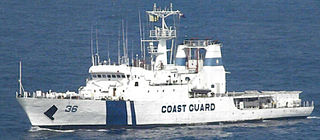
Vikram-class offshore patrol vessels are series of nine watercraft jointly built by Mazagon Dock Limited Mumbai and Goa Shipyard Limited, Vasco da Gama, Goa for the Indian Coast Guard.
Swallow Craft Class of Inshore Patrol Vessels are a series of watercraft built by South Korea's Kangnam/Swallow Craft, in Pusan for the Indian Coast Guard.

The Sa'ar 2 class ("Shalechet") is a class of missile boats built in Cherbourg, France at the Constructions Mécaniques de Normandie shipyard based on Israeli Navy modification of the German Navy's Jaguar-class fast attack craft. Three of the ships class were converted from Sa'ar 1-class patrol boats in 1974.
BRP Manuel Gomez (PC-388) is the seventeenth ship of the Jose Andrada-class coastal patrol craft of the Philippine Navy. She was commissioned with the Philippine Navy in 1996, and is currently in service with the Littoral Combat Force, Philippine Fleet.

The Esmeraldas-class corvettes are a class of corvette in service with the Ecuadorian Navy, built in Italy by Fincantieri, entering service in the early 1980s.

The Mandau-class, Indonesian designation KCR-PSK, is a class of four missile-armed fast attack craft that currently operated by the Indonesian Navy. They were built by the Korea Tacoma Marine Industries from South Korea between 1977 to 1980.

Fulton Shipyard was a shipbuilding company in Antioch, California. The shipyard was founded in 1924 by Frank Fulton and Angeline Fulton Fredericks. To support the World War II demand for ships, Fulton Shipyard built minesweepers, tugboats, and troopships. The shipyard was located on the Stockton Channel at 701 Fulton Shipyard Rd, Antioch, near Antioch pier and the Antioch Dunes National Wildlife Refuge. The site was the former Jarvis Brothers, opened in 1918, then Laurtzen shipyard. In 1977 the site became the California Corporation. The shipyard closed in 1999 and the land is owned by the Fulton Family Trust. Fulton Shipyard was on the San Joaquin River and an inland port located more than seventy nautical miles from the ocean, emptying into Suisun Bay. Fulton Shipyard was featured in a 1914 movie called The Stolen Yacht, a short drama film released on November 5, 1914. Frank Fulton and Angeline's son James Lloyd Fulton became an operator of a Fulton Shipyard tugboat.

Harbor Boat Building Company was a shipbuilding company on Terminal Island in San Pedro, California. To support the World War II demand for ships General Engineering built: minesweepers, torpedo boats, submarine chasers, and air-sea rescue boats. In 1919 Romolo Rados founded Harbor Boat Building. After the war he renamed the company Harco Shipyard and built and sold a standard design motor boat. In 1959 he sold the company to LTV. The shipyard was closed and the company was sold again in 1971 to Omega-Alpha, Inc. The last ship built was in 1965 for the US Navy. The shipyard was located at 263 Wharf St, San Pedro.
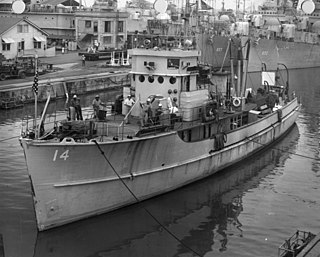
South Coast Shipyard was a shipbuilding company in Newport, California. To support the World War II demand for ships South Coast Shipyard built: minesweepers, Torpedo Boats, Submarine chasers, & Air-sea rescue boats. South Coast Shipyard was opened in 1938 by Walton Hubbard. After World War II the shipyard continued to build ships for the US Navy till 1955. The shipyard was located at 2300 Newport Boulevard, Newport, California. The shipyard closed in 1963.
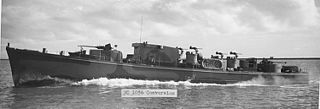
Wilmington Boat Works, Inc. or WILBO was a shipbuilding company in Wilmington, California. To support the World War 2 demand for ships Victory Shipbuilding built: Tugboats, crash rescue boats and sub chasers. Wilmington Boat Works opened in 1920 building Fishing boat and yachts, by Hugh Angelman, Willard Buchanan and Tom Smith. After the Korean War the shipyard closed in 1958. The shipyard was located at 400 Yacht Street, Wilmington, the site of the current USC boatyard.